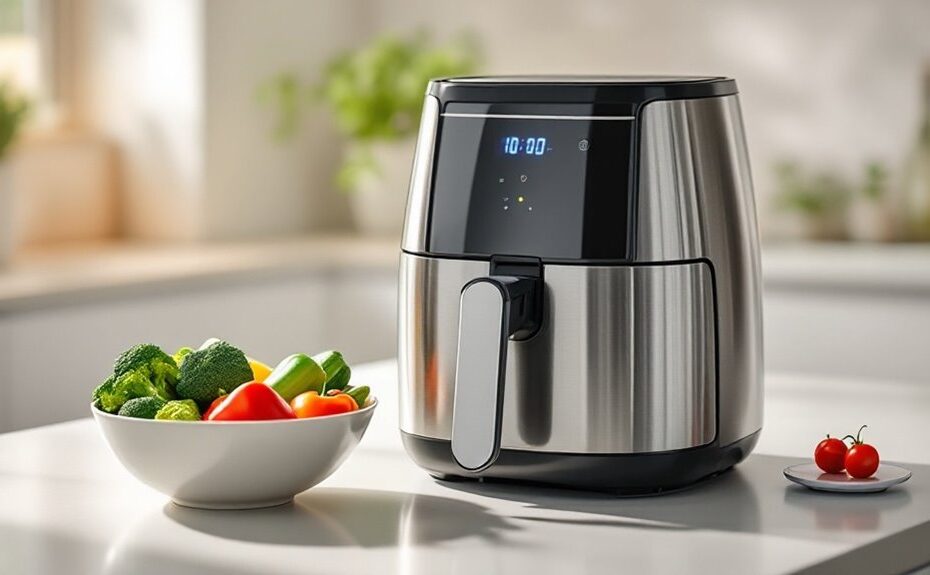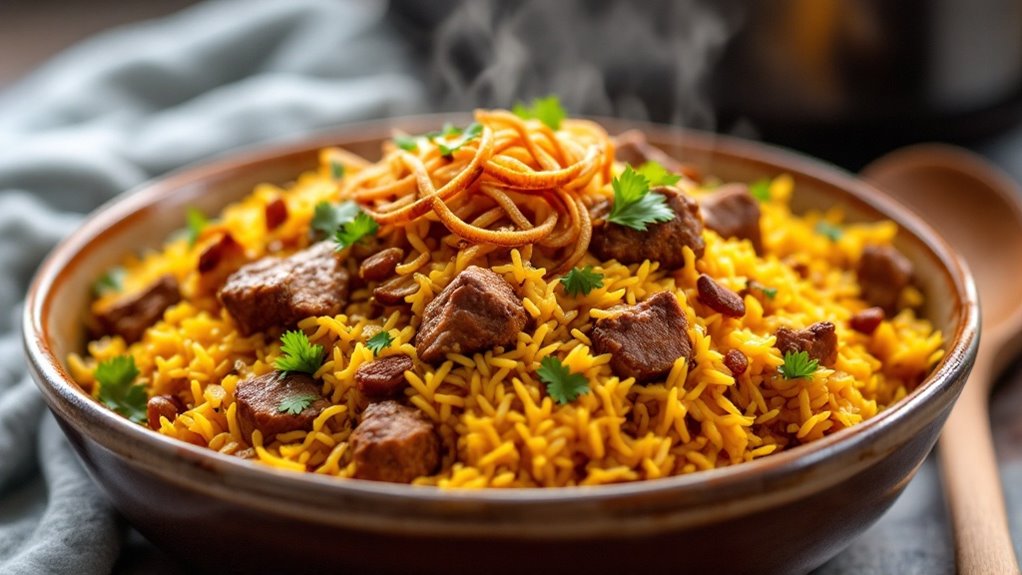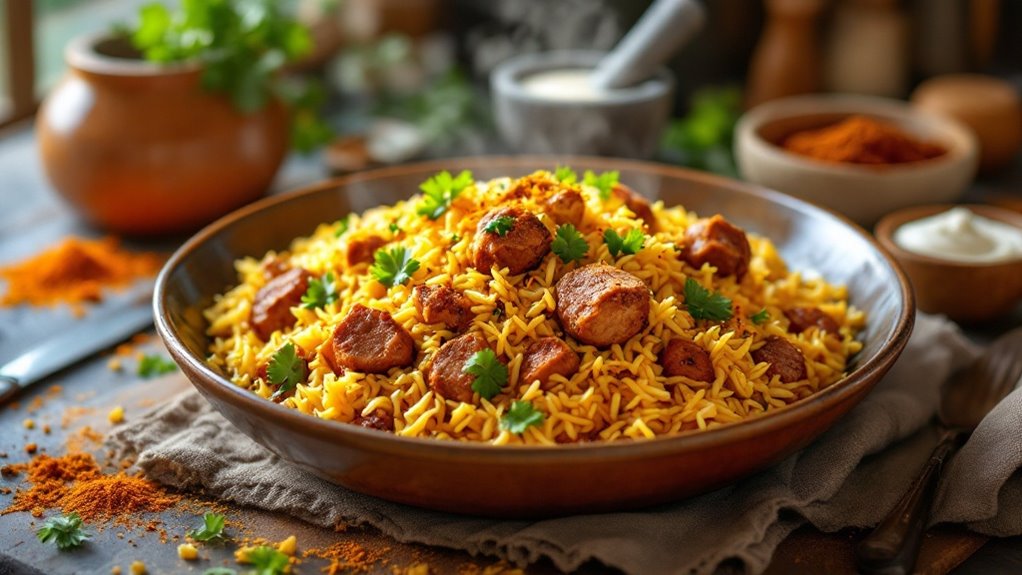If you're aiming for a low-calorie diet, an air fryer might just be your secret weapon. By using hot air instead of oil, it cuts calories substantially while still delivering that satisfying crunch you crave. But how does it compare to traditional frying, and can it really help you stick to your goals without sacrificing flavor? The answer lies in the foods you choose and the techniques you use. From crispy veggies to guilt-free snacks, the possibilities are vast—but there's more to uncover about making the most of this kitchen tool.
Key Takeaways
- Air fryers reduce calorie intake by cooking with 70-80% less oil compared to traditional frying methods.
- Air-fried foods like zucchini fries and sweet potato wedges are low-calorie, nutrient-dense options.
- Excess fat drips away during air frying, further lowering calorie content while maintaining crispiness.
- Air fryers minimize unhealthy fats and harmful compounds like acrylamide found in deep-fried foods.
- Use herbs, spices, and minimal oil alternatives like broth or citrus juice for flavorful, low-calorie meals.
How Air Fryers Reduce Calorie Intake
Air fryers reduce calorie intake by using hot air circulation to cook food with substantially less oil than traditional frying methods. When you compare air-fried foods to deep-fried ones, the calorie comparison is striking. For example, air-fried French fries can contain up to 70-80% fewer calories than their deep-fried counterparts. This is because air fryers require only a fraction of the oil, leading to significant fat reduction. By circulating hot air around the food, they create a crispy texture without submerging it in oil. You'll also notice that excess fat drips away during cooking, further lowering the calorie count. This method not only helps you cut calories but also reduces unhealthy fats, making it a practical tool for maintaining a low-calorie diet without sacrificing flavor or texture.
Best Low-Calorie Foods to Air Fry
When aiming to maintain a low-calorie diet, you can maximize the benefits of your air fryer by choosing foods that are naturally lower in calories and high in nutrients. Opt for calorie-conscious snacks like zucchini fries, which are rich in fiber and vitamins, or air-fried kale chips for a crunchy, nutrient-dense option. Vegetables such as broccoli, cauliflower, and Brussels sprouts caramelize beautifully in the air fryer, offering a satisfying texture with minimal calories. Lean proteins like chicken breast or tofu also work well, providing essential amino acids without excess fat. For a lighter alternative to traditional fries, try air-fried sweet potato wedges, which are packed with beta-carotene. These nutrient-dense options help you stay full while keeping your calorie intake in check.
Tips for Cooking With Less Oil
To reduce oil usage while cooking, an air fryer can be a game-changer since it requires substantially less oil than traditional frying methods. Use spray oils to lightly coat food, ensuring even coverage without excess. Opt for oil alternatives like broth, vinegar, or citrus juice to add moisture and flavor. Preheat your air fryer to prevent sticking and achieve a crispy texture with minimal oil. Pat food dry before cooking to enhance browning and reduce the need for added fats. Experiment with herbs, spices, and marinades to boost flavor without relying on oil. By adopting these strategies, you can maintain a low-calorie diet while enjoying delicious, healthier meals.
Comparing Air Fryers to Traditional Frying
Air fryers offer a healthier cooking method compared to traditional frying by substantially reducing oil usage. You can achieve crispy textures with up to 80% less oil, cutting calories without sacrificing taste. This makes air frying a practical choice for maintaining a low-calorie diet while still enjoying fried foods.
Healthier Cooking Method
While traditional frying relies on submerging food in oil, air fryers use rapid air circulation to achieve a similar crispy texture with substantially less fat. This method reduces the formation of harmful compounds like acrylamide, which can occur in deep-fried foods. Air fryer safety is enhanced by features such as automatic shut-off and cool-touch exteriors, minimizing risks of burns or overheating. Regular air fryer maintenance, like cleaning the basket and guaranteeing proper ventilation, secures consistent performance and prevents smoke or odors. By cooking with hot air instead of oil, you also avoid the greasy residue and lingering smells associated with traditional frying. This makes air frying a cleaner, healthier option for preparing meals while maintaining flavor and texture.
Reduced Oil Usage
Because traditional frying requires submerging food in oil, it often results in substantially higher fat content compared to air frying. Air fryers use hot air circulation to crisp food, requiring only a minimal amount of oil—or none at all—for similar results. This makes them an excellent tool for fat-free cooking or using oil alternatives like cooking sprays. Studies show air-fried foods can contain up to 70-80% less fat than their deep-fried counterparts, markedly reducing calorie intake. By eliminating the need for excessive oil, you can enjoy crispy textures without compromising your low-calorie diet. This method also reduces the risk of consuming unhealthy trans fats often associated with traditional frying. For healthier meals, air frying provides a practical solution to cut calories while maintaining flavor and texture.
Air Fryer Recipes for Weight Loss
If you're aiming to lose weight, incorporating air fryer recipes into your diet can be a practical and efficient strategy. Focus on meal prep ideas that prioritize lean proteins, vegetables, and whole grains. For example, air-fry chicken breasts with a light seasoning or roast a batch of mixed vegetables for easy, low-calorie sides. Portion control tips are essential; use smaller plates or containers to manage serving sizes and avoid overeating. Air fryers also allow you to prepare crispy, satisfying dishes without excess oil, such as zucchini fries or sweet potato wedges. By planning meals ahead and sticking to balanced portions, you can create a sustainable weight-loss plan. The air fryer's versatility guarantees you enjoy flavorful, nutrient-dense meals while staying within your calorie goals.
Maintaining Flavor While Cutting Calories
When cutting calories, you don't have to sacrifice flavor to meet your dietary goals. An air fryer excels in flavor retention while supporting calorie control. Its rapid air circulation creates a crispy texture without excessive oil, preserving the natural taste of ingredients. You can enhance dishes with herbs, spices, or citrus instead of high-calorie sauces or dressings. For example, marinate chicken with garlic, paprika, and lemon juice before air frying for a flavorful, low-calorie meal. The appliance also reduces the need for added fats, as its cooking method locks in moisture and taste. By focusing on whole, nutrient-dense foods and smart seasoning, you can enjoy satisfying meals that align with your calorie goals without compromising on flavor.
Disclosure: As an Amazon Associate, I earn from qualifying purchases.



